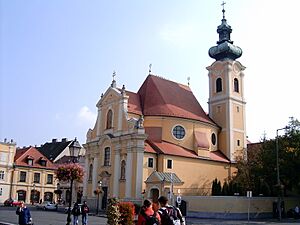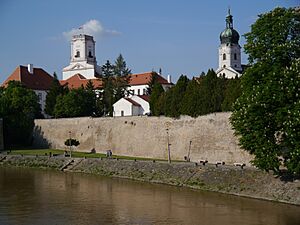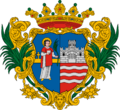Győr facts for kids
Quick facts for kids
Győr
|
|||
|---|---|---|---|
|
City with county rights
|
|||
| Győr Megyei Jogú Város | |||

Clockwise, from top to bottom: Cathedral Basilica of Győr, baroque architecture in Győr, Benedictine Church of Saint Ignatius of Loyola, street in the city center, City Hall, baroque architecture
|
|||
|
|||
| Lua error in Module:Location_map at line 416: Malformed coordinates value. | |||
| Country | |||
| Region | Western Transdanubia | ||
| County | Győr-Moson-Sopron | ||
| District | Győr | ||
| Area | |||
| • City with county rights | 174.62 km2 (67.42 sq mi) | ||
| Elevation | 108 m (354 ft) | ||
| Population
(1 January 2017)
|
|||
| • City with county rights | 129,301 | ||
| • Urban
(7th)
|
246,159 | ||
| Demonym(s) | győri | ||
| Population by ethnicity | |||
| • Hungarians | 84.5% | ||
| • Germans | 1.5% | ||
| • Romani | 0.8% | ||
| • Others | 1.7% | ||
| Population by religion | |||
| • Roman Catholic | 44.9% | ||
| • Evangelicals | 4.3% | ||
| • Calvinists | 4.1% | ||
| • Other | 1.5% | ||
| • Non-religious | 14.2% | ||
| Time zone | UTC+1 (CET) | ||
| • Summer (DST) | UTC+2 (CEST) | ||
| Area code(s) | (+36) 96 | ||
| Motorways | M1, M19, M85 | ||
| NUTS 3 code | HU221 | ||
| Distance from Budapest | 121 km (75 mi) East | ||
| International Airport | Győr (QGY) | ||
| MP | Róbert Balázs Simon (Fidesz) Ákos Kara (Fidesz) |
||
Győr (pronounced like DYUR or JUR) is a major city in northwest Hungary. It is the capital of Győr-Moson-Sopron County and the Western Transdanubia region. Győr is located between Budapest and Vienna, on an important road in Central Europe. It is the sixth largest city in Hungary and one of its seven main regional centers. The city has special "county rights," meaning it acts like its own county.
Contents
History of Győr
The area around the Danube River has been home to many different cultures for a very long time. The first big settlement was built around 500 BCE by the Celts. They called their town Ara Bona, which means "Good altar." This name later became Arrabona. This name was used until the 8th century. Even today, the German name (Raab) and Slovak name (Ráb) for the city come from this old name.
Roman merchants arrived in Arrabona in the 1st century BCE. Around 10 CE, the Roman army took over the northern part of Western Hungary. They named this area Pannonia. The Roman Empire left the area in the 4th century because of constant attacks from tribes. However, people continued to live in the town.
Around 500 CE, Slavs settled here. Then came the Lombards in 547, and the Avars from 568 to about 800 CE. During this time, the town was called Rabba and later Raab. Between 880 and 894, it was part of Great Moravia. After that, it was briefly under East Frankish rule.

The Magyars took over the town around 900 CE. They made the old Roman fortress stronger. Stephen I, Hungary's first king, created a bishopric (a church district led by a bishop) here. The town got its Hungarian name, Győr. This name probably comes from an old Hungarian personal name, Győr, who might have been the first count of the area. The town faced many challenges throughout Hungary's history. It was taken over by the Mongols in 1241–1242. Later, the Czech army destroyed it in 1271.
After the terrible battle of Mohács, Baron Tamás Nádasdy and Count György Cseszneky took the town for King Ferdinand I. At the same time, John Zápolya also tried to claim it. During the Ottoman occupation of central and eastern Hungary (from 1541 to the late 1600s), Győr's commander, Kristóf Lamberg, thought it was impossible to defend the town from the Turkish army. He burned the town down. The Turkish forces found only burnt ruins. This is why the Turkish name for Győr was Yanık kale, meaning "burnt castle."
During the rebuilding, the town was surrounded by a castle and city walls. These were designed by the best Italian builders of that time. The town changed a lot during these years. Many new buildings were built in the Renaissance style. However, the main square and the street layout stayed the same.
In 1594, the Ottoman army took over the castle and town. This happened after the death of Count János Cseszneky, who was a Hungarian infantry commander. In 1598, the Hungarian and Austrian army took control of it again. During the Turkish occupation, the city was called Yanık Kala, meaning "burned place." This name referred to the huge damage caused by the siege.
In 1683, the Turks returned for a short time. They left after being defeated in the Battle of Vienna.
Over the next centuries, the town became very successful. In 1743, Maria Theresa made Győr a "free royal town." This gave it special rights. Religious groups like the Jesuits and Carmelites settled there. They built schools, churches, a hospital, and a monastery.
On June 14, 1809, during the War of the Fifth Coalition, the Battle of Raab took place here. In this battle, the army of Eugène de Beauharnais defeated the Hungarian militia and an Austrian army. Napoleon's forces took over the castle and blew up some of its walls. The town leaders soon realized that the old walls were no longer useful. Most of the walls were destroyed, which allowed the town to grow.
In the mid-1800s, Győr's importance in trade grew. This was because steamship traffic started on the River Danube. However, the town lost its trade importance when the railway line between Budapest and Kanizsa became more popular than river travel after 1861. The town leaders made up for this loss by focusing on industry. The town did well until World War II. During the war, many buildings were destroyed. Large-scale strategic bombing damaged factories, homes, and the airport. Győr was a target because the Rába factory made tanks (Turán) and airplanes (Bf 109). One of these bombings even destroyed parts of a maternity hospital.
The 1950s and 1960s brought more changes. Only large apartment buildings were constructed. Old historical buildings were not taken care of. In the 1970s, work began to rebuild the city center. Old buildings were restored and repaired. In 1989, Győr won a European award for protecting its historical buildings.
An old Raba factory, which is 100 years old, is located near the historical center by the River Danube. It will be replaced by a new community called Városrét. This new area will have homes, shops, schools, clinics, and parks.
The city's main theater is the National Theatre of Győr. It was finished in 1978. It has large ceramic artworks made by Victor Vasarely.
Győr has many historical buildings. These include the castle and the Lutheran Evangelic church.
Climate and Weather
Győr has a climate that is similar to an oceanic climate (Köppen Cfb). It is also very close to a humid subtropical climate (Köppen Cfa). The average temperature for the whole year is 11.1 °C (52.0 °F). July is the hottest month, with an average of 21.6 °C (70.9 °F). January is the coldest, with an average of 0.3 °C (32.5 °F).
The city gets about 569.6 millimetres (22.43 in) of rain each year. July is the wettest month, with 64.8 millimetres (2.55 in) of rain. February is the driest, with only 26.9 millimetres (1.06 in). The lowest temperature ever recorded was −22.1 °C (−7.8 °F) on December 28, 1996. The highest was 40.6 °C (105.1 °F) on August 8, 2013.
| Climate data for Győr, 1991−2020 normals | |||||||||||||
|---|---|---|---|---|---|---|---|---|---|---|---|---|---|
| Month | Jan | Feb | Mar | Apr | May | Jun | Jul | Aug | Sep | Oct | Nov | Dec | Year |
| Record high °C (°F) | 17.5 (63.5) |
20.5 (68.9) |
23.4 (74.1) |
31.2 (88.2) |
33.1 (91.6) |
36.6 (97.9) |
39.6 (103.3) |
40.6 (105.1) |
33.7 (92.7) |
28.1 (82.6) |
23.4 (74.1) |
17.6 (63.7) |
40.6 (105.1) |
| Mean daily maximum °C (°F) | 3.5 (38.3) |
6.4 (43.5) |
11.6 (52.9) |
17.8 (64.0) |
22.2 (72.0) |
26.0 (78.8) |
28.2 (82.8) |
27.9 (82.2) |
22.3 (72.1) |
16.4 (61.5) |
9.8 (49.6) |
4.2 (39.6) |
16.4 (61.5) |
| Daily mean °C (°F) | 0.3 (32.5) |
2.1 (35.8) |
6.3 (43.3) |
11.7 (53.1) |
16.2 (61.2) |
19.9 (67.8) |
21.6 (70.9) |
21.1 (70.0) |
16.2 (61.2) |
10.9 (51.6) |
6.0 (42.8) |
1.3 (34.3) |
11.1 (52.0) |
| Mean daily minimum °C (°F) | −2.7 (27.1) |
−1.6 (29.1) |
1.7 (35.1) |
5.9 (42.6) |
10.3 (50.5) |
14.1 (57.4) |
15.6 (60.1) |
15.0 (59.0) |
11.0 (51.8) |
6.6 (43.9) |
2.8 (37.0) |
−1.4 (29.5) |
6.4 (43.5) |
| Record low °C (°F) | −18.4 (−1.1) |
−20.4 (−4.7) |
−15.2 (4.6) |
−6.1 (21.0) |
−1.4 (29.5) |
3.6 (38.5) |
7.3 (45.1) |
6.8 (44.2) |
0.5 (32.9) |
−9.5 (14.9) |
−11.5 (11.3) |
−22.1 (−7.8) |
−22.1 (−7.8) |
| Average precipitation mm (inches) | 32.7 (1.29) |
26.9 (1.06) |
37.5 (1.48) |
35.8 (1.41) |
63.1 (2.48) |
59.1 (2.33) |
64.8 (2.55) |
58.4 (2.30) |
59.3 (2.33) |
48.2 (1.90) |
46.4 (1.83) |
37.4 (1.47) |
569.6 (22.43) |
| Average precipitation days (≥ 1.0 mm) | 6.3 | 6.2 | 7.1 | 5.6 | 8.3 | 7.2 | 7.7 | 6.3 | 6.8 | 6.5 | 7.6 | 6.7 | 82.3 |
| Average relative humidity (%) | 82.2 | 75.8 | 68.5 | 63.2 | 66.5 | 67.0 | 66.5 | 68.5 | 74.1 | 78.9 | 82.4 | 84.0 | 73.1 |
| Mean monthly sunshine hours | 60 | 97 | 138 | 189 | 247 | 250 | 268 | 259 | 188 | 143 | 73 | 51 | 1,963 |
| Source 1: Meteorological Service of Hungary (sun 1981-2010) | |||||||||||||
| Source 2: NOAA | |||||||||||||
Main Sights to See
The oldest part of the city is Káptalan Hill. It's where three rivers meet: the Mosoni-Danube, Rába, and Rábca. Püspökvár, which is the home of Győr's bishops, is easy to spot with its unique tower.
Győr's oldest buildings include a 13th-century dwelling tower and the 15th-century Gothic Dóczy Chapel. The main church, called the cathedral, was first built in a Romanesque style. It was later rebuilt in Gothic and Baroque styles.
Other interesting places to visit include:
- Town Hall
- Benedictine church of St. Ignatius of Loyola
- Carmelite church
- Museum of Roman Archaeology
The Pannonhalma Archabbey is a famous monastery located about 20 km (12 miles) outside the town.
City Renovation Projects
After the year 2000, Győr started many large building and renovation projects.
Some of the bigger changes include:
- The Nádor-underpass, which helped reduce traffic in the downtown area. This also made it possible to renovate the Baross-Bridge.
- The renovation of the Baross-Bridge.
- The old Soviet barracks and Bus Station were renovated by a company called Leier.
- Széchenyi István University was developed. It works closely with AUDI Hungária ZRT.
- New parking garages were built. These help with the heavy traffic in the downtown area, like the József Attila and Dunakapu garages.
- The inner-downtown area was renovated. This included Széchenyi-square, Dunakapu-square, and the areas next to the Moson-Danube and Rába rivers.
- A free city bus was introduced. Everyone can use it to get around the Downtown Area.
- The Győr Arcade at Városliget.
- The Kálóczy Square near the Széchenyi István University.
- The Jedlik Bridge, which made it easier to travel between the Sziget and Révfalu districts.
- The Rába Quelle thermal spa.
Economy and Industry
Audi AG has a large factory in Győr. It's run by their company Audi Hungaria Zrt.. This factory builds the Audi TT sports car, the A3 Cabriolet, and the A3 Limousine. They also build many engines here. In 2007, they made over 1.9 million engines!
The factory opened in 1994. At first, it only made engines for Audi cars. Then, they started putting together the Audi TT Coupé and TT Roadster. Later, they also began making V6 and V8 engines. After Audi bought Automobili Lamborghini S.p.A., they started building V10 engines too. The V10 engines for Audi cars are fully put together here. For Lamborghini V10s, only the main engine blocks are made here. Engines from this factory are also sent to other car brands owned by the Volkswagen Group. More than 90% of Audi car engines are made in Győr. By 2020, the factory had a huge solar roof that produces a lot of electricity.
Notable People from Győr
Many interesting people have come from Győr, including:
- Tamás Bakócz, an archbishop
- Miklós Borsos, a sculptor
- György Cseszneky, a count and castle commander
- János Cseszneky, an infantry commander
- Freddie, a singer
- Anita Görbicz, a famous handball player
- Ányos Jedlik, an inventor
- Margit Kovács, a ceramic artist
- Desiderius Orban, a painter
- Antal Pusztai, a guitarist
- Hans Richter, a conductor
- Frigyes Riesz, a mathematician
- Marcel Riesz, a mathematician
- Samuel Aba, a king of Hungary
- Tibor Varga, a violinist
- Emil Zuckerkandl, an anatomist
Transportation Hub
Győr is a very important place for both train and road traffic in Hungary. Its location is excellent for transport. The most important railway lines include the Vienna-Budapest line. There are also lines owned by the Győr-Sopron-Ebenfurt railway company, and lines run by MÁV (the Hungarian state railway).
Several main roads and motorways meet in Győr, such as the M1, M19, and others. This makes it easy to reach the city from many directions. Győr-Pér Airport is about 15 km (9.3 mi) from the city, along Highway 81 towards Székesfehérvár. The port of Győr-Gönyű is located on the Danube River. It has a fully equipped terminal for shipping goods.
Sports in Győr
Győr is home to the Győri ETO Sport Club, which has many different sports teams. The most popular sport in the city is handball. The main team is Győri ETO KC. This team has won the Champions League several times: in 2013, 2014, 2017, 2018, and 2019. They also reached the final in 2009, 2012, and 2016. In addition, Győr reached the final of the EHF Cup Winners' Cup in 2006 and the final of the EHF Cup in 1999, 2002, 2004, and 2005.
WKW ETO FC Győr is the city's football (soccer) team. As of the 2023/2024 season, they play in the Hungarian Second Division.
Twin Towns – Sister Cities
Győr has twin city relationships with several cities around the world:
 Brașov, Romania
Brașov, Romania Colmar, France
Colmar, France Erfurt, Germany
Erfurt, Germany Ingolstadt, Germany
Ingolstadt, Germany Kuopio, Finland
Kuopio, Finland Nizhny Novgorod, Russia
Nizhny Novgorod, Russia Nof HaGalil, Israel
Nof HaGalil, Israel Poznań, Poland
Poznań, Poland Sindelfingen, Germany
Sindelfingen, Germany Wuhan, China
Wuhan, China Dunajská Streda, Slovakia
Dunajská Streda, Slovakia
Images for kids
See also
 In Spanish: Győr para niños
In Spanish: Győr para niños









